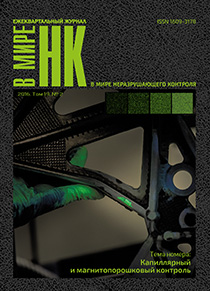Har'kov, Ukraine
Introduction. Magnetic structural analysis with the use of double-pole magnetizers is widely used for non-destructive evaluation of properties and a stress-strain state of ferromagnetic products. Measurements of material parameters are usually accompanied with high energy consumption, necessary for product magnetization (reversal magnetization) with electromagnets. This paper offers a simple and reliable magnetic structure analyzer, which includes a magnetizer on the basis of permanent magnets, and a probe of the tested object "internal field". Method. Theoretical and experimental researches of the magnetic circuit "magnetizer – product" were conducted. The dependence between magnetic permeability and "internal field" of the tested product was determined with the use of a magnetic circuit calculation method. For experimental study the magnetic structure analyzer was used. It included a U-shaped magnetizing device containing two permanent magnets (made of neodymium–iron–boron) closed with ferromagnetic connection strap, and the Hall probe located between the poles of the magnets. The tangential component of the magnetic field strength over the sample surface was measured. Results. Measurements were performed on four ferromagnetic specimens with the coercive force range from 1.5 till 17.2 A/cm at different magnet pole gaps and different distances between the Hall probe and the sample surface. The results have shown that the change in the product magnetic permeability is due not only to the "internal field" in it, but to the magnetic field strength, measured at a considerable distance from the product surface. Discussion. The magnetic structure analyzer enables the product structural condition (the stress-strain state or fatigue state) to be determined continuously and with small energy consumption. The device makes it possible in the future to create a system for continuous monitoring and residual resource forecasting of important products, which are in prolonged use and critically influence upon anthropogenic safety.
magnetic field strength, magnetic permeability, the internal field of the magnet, the magnetic resistance
1. Tomáš I., Vértesy G. Magnetic Adaptive Testing. Nondestructive Testing Methods and New Applications. 2012, no. 3, pp. 145-186. Available at: http://www.intechopen.com/books/nondestructive-testing-methods-and-new-applications/magnetic-adaptive-testing (accessed on 11.05.2016).
2. Vlasov V. T., Dubov A. A. Fizicheskie osnovy metoda magnitnoy pamyati metalla [The Physical Basis of the Metal Magnetic Memory Method]. Мoscow, OOO «Energodiagnostika», 2007, 424 p. (in Russ.).
3. Gorkunov E. S., Zakharov V. A. Defektoskopiya, 1995, no. 8, pp. 69-88 (in Russ.).
4. Tabachnik V. P., Chernova G. S., Fedorishcheva E.E. Defektoskopiya, 1984, no. 11, pp. 3-7 (in Russ.).
5. Kostin V. N.; Osintsev A. A.; Stashkov A. N.; et al. Portable instruments for multiparameter magnetic evaluation of material structures. Russian J. Nondestructive Testing. 2008, v. 44, no. 4, pp. 280-289.
6. Kostin K. V., Tsar´kova T. P., Nichipuruk A. P., Smorodinskiy Ya. G. Measurement of the hysteresis characteristics of pipe steels under elastic and plastic tensile strain. Russian J. Nondestructive Testing. 2011, v. 47, no. 9, pp. 593-602.
7. Kostin V. N., Osintsev A. A., Stashkov A. N., Tsar´kova T. P. Multiparameter Methods for Structural Analysis of Steel Articles Using the Magnetic Properties of Substances. Russian J. Nondestructive Testing. 2004, v. 40, no. 3, pp. 197-208.





